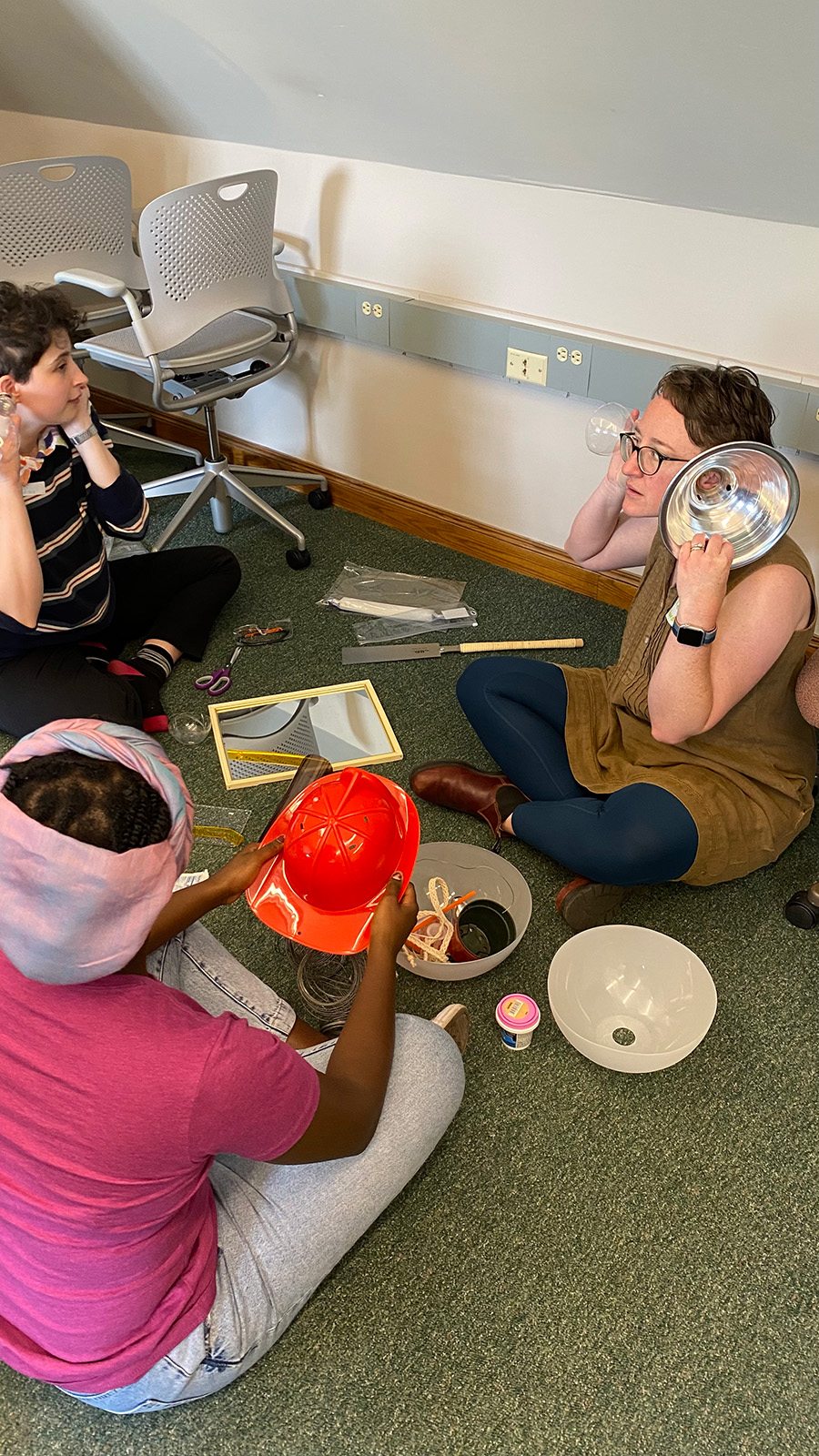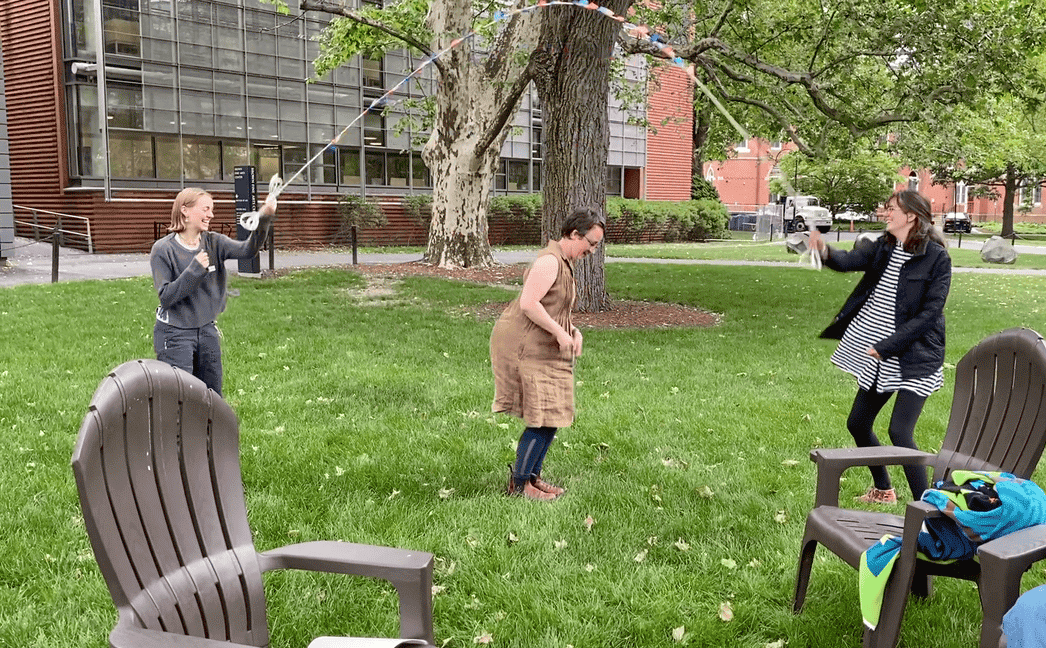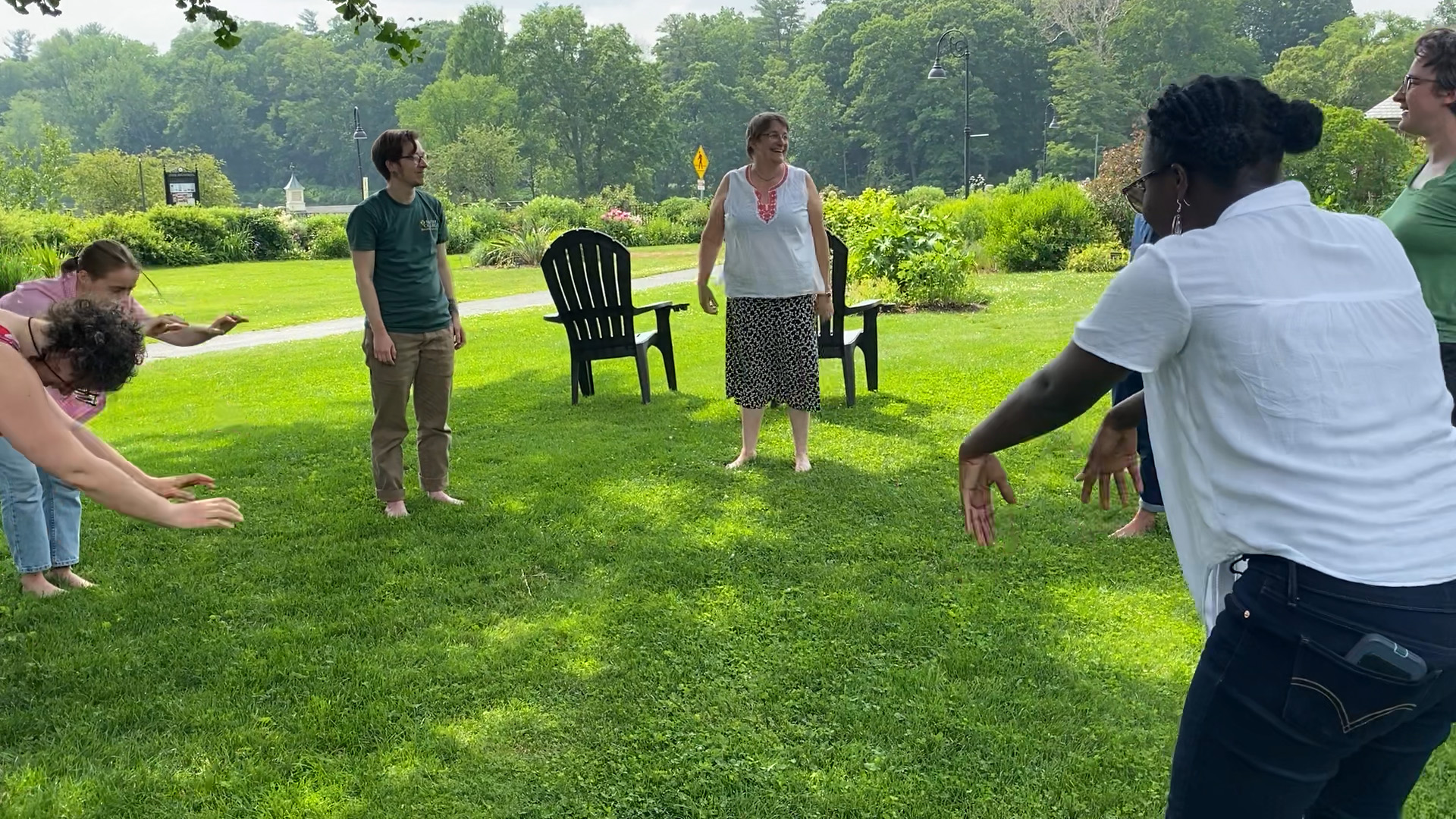May 2023 - June 2023
Text by Millie Howard & Alix Gerber
Making Radical Futures Lab
A Humanities Lab at Smith College that explores collaborative ways of imagining futures without capitalism.
Summer ‘23 Lab organized by Alix Gerber / Research assistants: Millie Howard, Mirriam Nzunda, Phoebe Kolbert / Members: Amy Putnam, Emily Norton, Javier Puente, Kathy Guo, Megan Lyster
Making Radical Futures is a Humanities lab at Smith College that uses practices from participatory and speculative design to explore collaborative ways of imagining futures without capitalism. We believe that design and making provide tools to strengthen our imaginations and break free from the intellectual confines constructed by capitalist hegemony. We co-create immersive experiences and games that imagine different social systems for producing and distributing what we need, through the lens of closer interpersonal ecosystem interactions.
Summer ‘23 Lab organized by Alix Gerber / Research assistants: Millie Howard, Mirriam Nzunda, Phoebe Kolbert / Members: Amy Putnam, Emily Norton, Javier Puente, Kathy Guo, Megan Lyster
Making Radical Futures is a Humanities lab at Smith College that uses practices from participatory and speculative design to explore collaborative ways of imagining futures without capitalism. We believe that design and making provide tools to strengthen our imaginations and break free from the intellectual confines constructed by capitalist hegemony. We co-create immersive experiences and games that imagine different social systems for producing and distributing what we need, through the lens of closer interpersonal ecosystem interactions.
In Summer 2023, the lab kicked off with a 5-week session, where ten lab members (faculty, staff, and students from across disciplines) came together to plan and facilitate a series of three workshops. Workshops centered on 1) rooting ourselves in an understanding of how capitalism manifests in our lives, 2) making objects from futures without capitalism, and 3) tuning into our senses to allow more-than-human collaborators to guide us into futures beyond capitalism. Throughout, we grappled with the creative paralysis that capitalist hegemony sustains. We used design practices such as: making things tangible to show our visions to each other, working iteratively with a focus on process over any particular outcome, and building knowledge collaboratively in a way that recognizes each participant’s partial understanding. Activities like word mash-ups, role playing games, and worldbuilding mindmaps built lab members’ confidence in coping with the unknown and generatively envisioning possible futures together.
Facilitated by Millie Howard, Megan Lyster, and Javier Puente
Workshop 1: What is capitalism?
Facilitated by Millie Howard, Megan Lyster, and Javier Puente

The first workshop focused on establishing a common vocabulary and grappling with how capitalism is entangled with our everyday routines. First, we aligned on vocabulary through a game, where members matched words to children’s toys such as dice and juggling balls. For example, one participant said ‘Communism’ was like a juggling ball because the ball can represent a larger vision which requires significant collaboration and unity amongst pieces of the system. Next, we read and discussed an excerpt from Disassembly Required by Geoff Mann, and finally, we filled out exploratory worksheets aiming to understand the underlying capitalist mechanisms and pressures that influence the way we live out our daily routines. For example, we discussed the way that drinking coffee –a stimulant– ultimately serves to increase productive capacity and make money for corporations without increasing employee pay.

Questions we left with:
Facilitated by Phoebe Kolbert, Emily Norton, and Kathy Guo
- We’re all coming from very different knowledge backgrounds about what capitalism is. How do we share what we know and build a collective understanding?
- How do we recognize the impact of capitalism on everything while also recognizing that there are other factors at play- how do we understand the edges of capitalism?
- How do we understand the ‘structural mechanisms’ of capitalism, not just the ideology around it? How do we imagine differently at that level?
Workshop 2: Making for reciprocity
Facilitated by Phoebe Kolbert, Emily Norton, and Kathy Guo




Our second workshop gave us an opportunity to imagine a world that prioritized reciprocity, as defined by Robin Wall Kimmerer. Kimmerer speaks about “the covenant of reciprocity, that for the Earth to stay in balance, for the gifts to continue to flow, we must give back in equal measure for what we take” (Kimmerer, Returning the Gift, 2013). Using words related to reciprocity, we created mash-ups that would frame our own visions of reciprocal worlds. For example, interconnectedness, cyclical, and curiosity became “intercycliuriosity: the all-encompassing perspective of continuous question-asking, particularly examining connections with others, human and non-human.” In groups, we used these words as prompts to make an object or infrastructure that would help us practice a more reciprocal way of being, for example a way of being ‘intercycliurous’.
In the end, teams created three objects/performances:
Questions we left with:
Facilitated by Mirriam Nzunda and Amy Putnam
In the end, teams created three objects/performances:
- Cooplaymunity: a community of persons who make decisions together by being playful and approaching problems with lightness and generosity. They use play to do the necessary work of the group. This team created a jump rope mop and a rolling mop, tools for people who live together to clean their home playfully and collaboratively.
- Relatureful: embracing play and emergence with the understanding that if harm, discordance, or mistakes happen that nurturing and repair will bring us back into relation. This team created a community-building game in which members collaborate to pass small objects around in a circle without using their hands, therapeutically wailing together whenever an object is dropped and practicing giving and accepting apologies in order to repair relational harms.
- Intercycliuriosity: the all-encompassing perspective of continuous question-asking, particularly examining connections with others, human and non-human. This team created a pair of “consequence goggles” which would allow designers, architects, and engineers to see the impacts of their proposed creations on the environment and ecosystems of the future.
Questions we left with:
- How can mashing up words and concepts enable inspiring and focused frames for envisioning?
- What role does language play in facilitating or resisting change to our mindsets and ideas?
- How can play make space to generate divergent ideas?
Workshop 3: Learning from Non-human Ecosystem Relationships
Facilitated by Mirriam Nzunda and Amy Putnam


The third workshop we held let us allow more-than-humans to guide us into futures beyond capitalism through connection with our five senses. We learned from the symbiotic relationship between Matsutake and Red Pine in Anna Tsing’s book The Mushroom at the End of the World to understand what it means to be connected in the wake of disturbance and violence. We created a ‘wood wide web’ of yarn around trees to represent and be able to visualize mycorrhizal relationships between plant and fungi, and noticed what it felt like to re-wind our skeins and trace back our paths, untangling the web.


We isolated our senses, being with the surrounding ecosystem in silence and paying attention to what new sensations and occurrences we noticed when each of our senses were restricted.

To end, we learned dances from plants to celebrate the human-ecosystem collaborations that are possible to cultivate as we move towards a world without capitalism.
Questions we left with:
Questions we left with:
- What is the role of human disturbance in natural ecosystems? When is it necessary and when is it harmful – or both?
- Can we learn to understand and acknowledge conflicting needs in ecosystems and communities?
- How do we develop deeper, reciprocal relationships with more-than-human communities?
- How do we communicate with non-humans like plants and insects? What language do they speak?